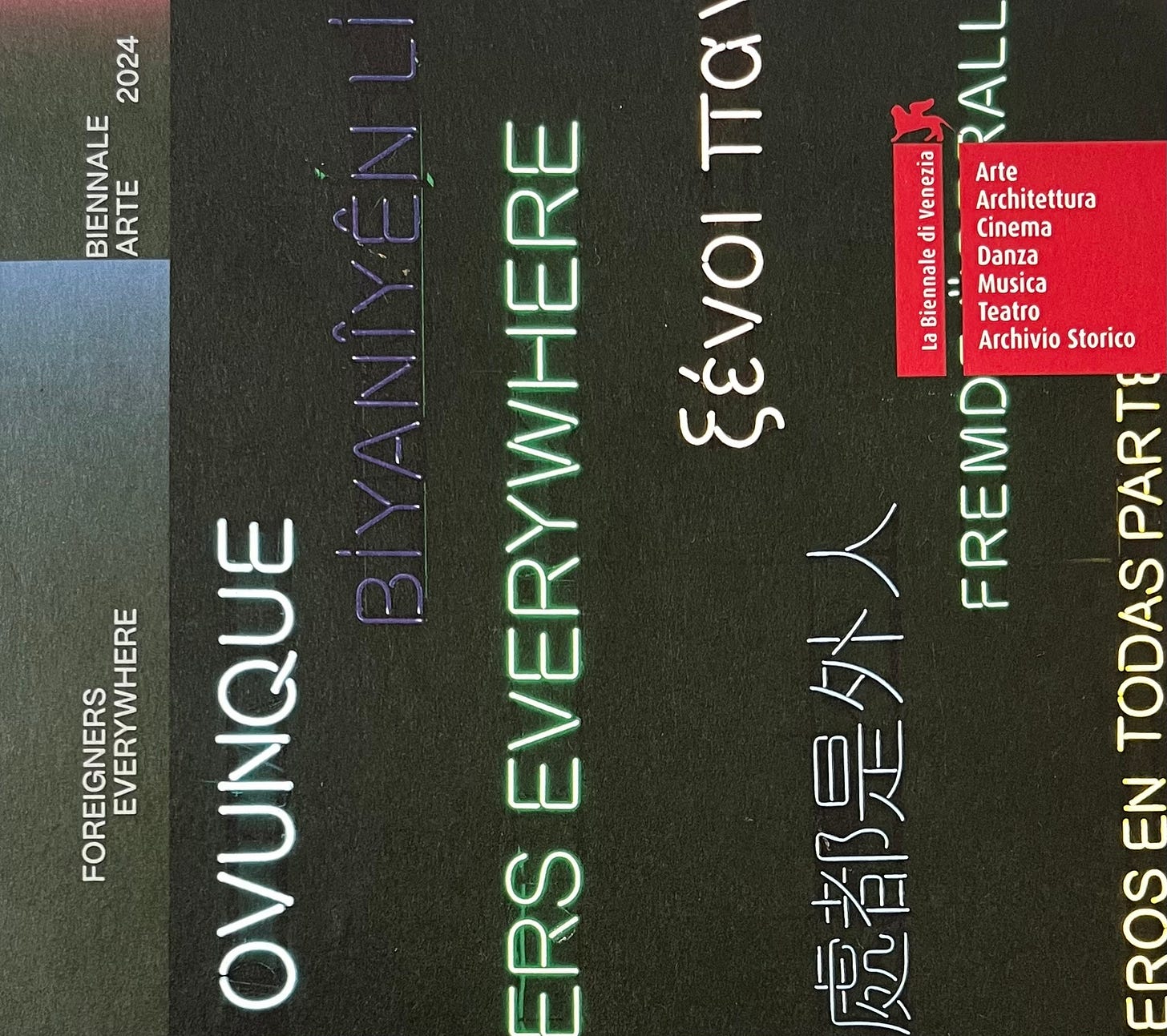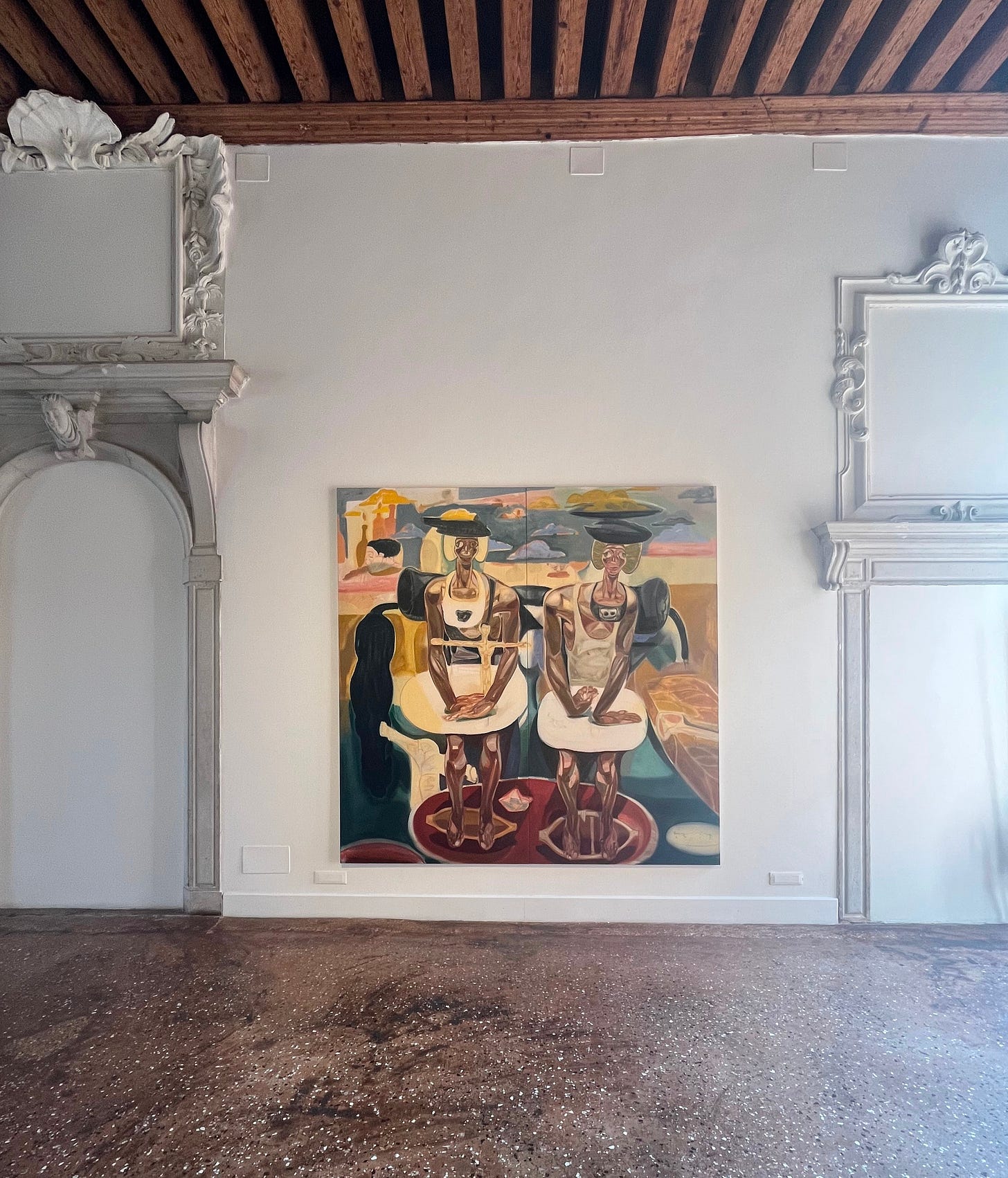A Slowbrow Guide to the 60th Venice Biennale
PART ONE: COLLATERAL EVENTS AND A DELICIOUS PIT STOP
10.07.24. It’s about 19:30. Outside on the waterway beneath our Airbnb, the young men of Venice are taking their boats out for a spin. Each one of them alone, smoking performatively, blasting Italian reggaeton with one hand on the wheel. Not my kind of music, but I find myself bopping along from behind the curtains of our bedsit in a 16th century house off the Via Garibaldi. I’m bopping along given the context. Given the late evening sun, the gulls screeching on the wind, the promise of 4 days of nothing but ART. Megan has gone out to buy prosciutto. I’m responsible for the Caprese salad.
I spend the next days sipping espressos (espressi?) by the Venetian Laguna, mainlining mozzarella & trotting between the various venues of the 60th Biennale Arte until my feet hurt. Now, armed with scribbly notes and a much-filled external memory vault (my camera roll), I’m going to dissect, discuss and drip-dry my impressions of this colossal international exhibition. Then, if you’re a real art hoe, you’ll try and go before it closes on the 24.11. of this year. Enjoy.
Strangers Everywhere – Stranieri Ovunque
Venice’s biannual international art exhibition has been going on for 129 years. It’s basically the Art Olympics. Taking over the Giardini Central Pavilion, Arsenale Corderie & Artigliere, Forte Marghera and various collateral buildings around Venice (including some gorgeous palazzos) every two years, it’s the world’s first international art exhibition - and a true feat. It began in an era of world fairs - grand displays of cultural capital on a newly international stage. There has always been beautiful, skilful and sometimes genius work at the Biennale. But (as with any institutional event) there have also always been insiders and outsiders. That’s why this year’s theme, Foreigners Everywhere, along with the curator who chose it, is different.
Adriano Pedrosa, the exhibition’s first ever South American curator, really went for radical inclusion. And yes, even typing those words I recognise that they feel buzzy and meaningless, but this is one of the rare instances where they can be taken at face value.
Pedrosa’s curation of the International Exhibition is a reset - yet all it does is take the idea of an international exhibition literally. This year’s Biennale highlights an astounding number of artists from indigenous, marginalised and historically oppressed groups, and is a genuine step towards inclusion without coming across as tokenistic or preachy. It questions what the West views as art, and what kind of objects the market values.
A huge amount of exhibition texts are peppered with the endnote: “this is the first time the work of ___ is presented at Biennale Arte”. Works are at times confrontational, explicitly political – and often tender at the same time. Made with love, and skill. There is an explicit celebration of textile, craft and tradition over and above canonised ‘Fine Art’. It wasn’t what I was expecting – but I loved it. And importantly, I came out of the whole thing a lot more educated.
If you want to read more about Pedrosa’s curatorial rationale, you’re best placed to hear it directly from him. I’m here to share my subjective impressions and gush about what I encountered.
The Collateral Events
A 3-day pass to the Biennale will set you back €40,5. If you have a week to spare, get a 7-day pass instead. There’s a lot to see. We were pressed for time and on a budget, so spent the first day on the collateral pavilions before visiting the ticketed exhibitions during the last 3 days of our trip.
Desde San Juan Bautista…, an exhibition on the struggle against enduring colonial power in Puerto Rico, was the first we stumbled across. Tucked away in a little side street behind the Arsenale, it packed an educational punch and set the tone for what would prove to be an eye-opening visit through various post- and neo-colonial stories over the course of the weekend.
Hopeful, spirited, but with a strong sense of frustration, the four Puerto Rican artists directly addressed the ongoing imbalance of power held by the USA over their island nation, and its continuing status as an ‘unincorporated territory’ of one of the world’s largest superpowers[1]. The vulnerable force of Awilda-Sterling Duprey’s Blindfolded Performance (2022) highlights the warp and dissociation of cultural identity resulting from, let’s call it what it is, the USA’s ongoing colonial rule over Puerto Rico.
Puerto Rico’s political status is further addressed in the Giardini Central Pavilion in Pablo Delano’s The Museum of the Old Colony, an installation of archival material including colonial artefacts, footage and deep-cutting extracts from US media coverage of Puerto Rico and its people over the years. It felt more like a history museum than an art exhibition, but I’m not mad about it – quite the contrary. More people should be paying attention.
Tesfaye Urgessa heads up Ethiopia’s debut at the Biennale with Prejudice and Belonging[2]. Inhabiting the gorgeous Palazzo Bollani’s high-ceilinged, terrazzo-floored rooms, the artists paintings appear to have lived there forever. I was a fan of Urgessa’s work before the Biennale, and my appreciation has only grown.
There is a truly original beauty to Urgessa’s large canvases and the regal, dancing bodies that inhabit them. German neo-expressionist influence hails from the artist’s studies at the Staatliche Akademie der Bildenden Künste in Stuttgart. Its marriage with Ethiopian iconography is a divine combination – creamy, warm pigments soften the anatomically sharp, sculpted lines of faces, arms, flexed hands in the vein of Schiele. A truly hypnotic experience and an artist to watch – one who is driving an evolution of aesthetic tradition without being derivative.
Jerūiyq: Journey Beyond the Horizon is the title of the Republic of Kazakhstan’s contribution to this year’s Biennale. The theme’s eponymous land of ancient Kazakh myth is a starting point for a collection of works that center around land, belonging and utopian futures for a nomadic people. Yerbolat Tolepbay’s New Child. Rebirth, is a modernist meditation that instinctively calms the spirit. I love the thread of union and community that pulls this show together – Soviet repression, political struggle and colonialism are addressed and contextualise the works, but the overall feeling is one of optimism and looking towards new horizons.
Hong Kong’s collateral exhibition Trevor Yeung: Courtyard of Attachments reawakened a sense of childhood wonder in me – so, in my opinion, a successful collection of artworks. His site-specific installation of fishless aquariums, plastic splash pools and vacant goldfish bags à la Nemo were a refreshing end to a day spend indoors in the sweltering Italian heat. The only thing I didn’t like is that I couldn’t take a dip.
Pit-stop
Although art feeds the soul, it feeds the body not. So here’s a pit-stop, appropriately focussed around the ones we made between exhibitions. For more art, you’ll need to wait another week. Consider this a delicious appetiser.
Kitchenette caprese. Not a restaurant. But, when in Italy, take advantage of the reasonably-priced and flavourful fresh produce in your local supermarket. Especially if you’re on a budget. We snacked on Peroni, Caprese salad and Parma ham. Not revolutionary, but if you’re staying in a 16th century house by a Venetian canal, elevated enough.
InParadiso. We had our daily morning espresso at InParadiso, a café with a shaded terrace that overlooks the Laguna on one side, and the entrance to the Giardini on the other. They also have their own, in-house gallery. The coffee is good[3], there’s a breeze, and you’re mere steps away from the gates to the Biennale.
Illy kiosks. We had the same lunch from the Illy kiosk inside the Biennale grounds every day, and didn’t regret it. Of course, your ticket guarantees you re-entry - but the €6 mozzarella & prosciutto baguettes really hit the spot if you want to get right back to the art after your lunch break.
Vino Vero. A natural wine bar in Cannaregio, Vino Vero offers classic Venetian Chicchetti[4] with an impressive selection of natural wines. They’ve also just opened one in Lisbon, which is equally as atmospheric.
We arrived VERY sweaty and thirsty, and the staff kindly let us try our way through various sorts until I landed on a deliciously dry Moscato. If you can’t find a table, just plonk yourself down on the edge of the canal right outside the bar. And be quick with the Cicchetti – when they’re gone, they’re gone. Think: speck & baba ghanouj, hummus with smoked paprika and burrata, smoked salmon with fresh samphire.
Bacaro del Gelato. Vino Vero’s next-door neighbour on the Fondamenta de la Misericordia is this little gelateria, reassuringly popular with the locals. We saw a family of five pull up in their boat, order a round of cones and relish them to the last bite, so naturally, we had to try. I’m a huge Fior di Latte fan, but they’ve got all the classics (and more). Plus: the proprietor seems incredibly zen. No screaming tourist children here, just good ice cream.
NEXT TIME: ARSENALE, GIARDINI, AND SOME VERY STRONG CAMPARI.
SEE YOU THERE?
[1] I’m embarrassed to say I had no idea that the Puerto Rican head of state is the President of the United States of America, yet Puerto Ricans are not legally able to vote in US elections. Read more about it here.
[2] A deceptively basic title for a collection of works which transcends common artistic tropes of identity and belonging.
[3] They’ve even got proper espresso spoons. I was tempted to slip one into my pocket, but didn’t want to be an asshole tourist.
[4] Small bites, usually bread with a couple of yummy deli toppings and heated up on a little hot plate.









